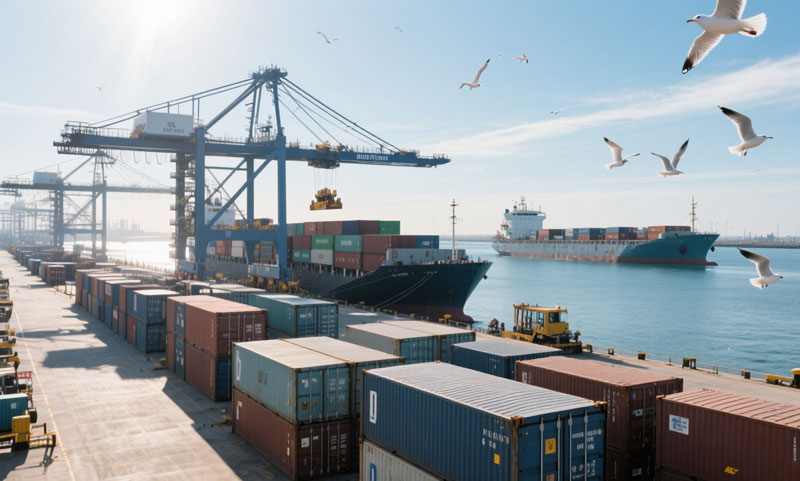Global trade expanded by $300 billion in H1 2025—but storm clouds gather as tariff wars and policy uncertainty threaten H2 stability.
H1 Performance: Services Lead Amid Fragile Growth
Global trade recorded a $300 billion surge in the first half of 2025, with Q1 growth at 1.5% accelerating to 2% in Q2. Yet beneath the headline figures, critical vulnerabilities emerged:
Services trade dominated, growing 9% year-on-year, while goods trade lagged due to weak manufacturing demand .

Price inflation masked weak volumes: Overall trade value rose largely because of increasing prices, while actual trade volume growth stagnated at just 1%.
Deepening imbalances: The U.S. deficit widened dramatically, even as the EU and China saw rising surpluses. U.S. imports jumped 14%, and EU exports rose 6%, reversing earlier trends favoring Global South economies.
This growth, though positive, relied on temporary factors—notably front-loaded imports ahead of anticipated tariffs—rather than organic demand.
Mounting H2 Headwinds: Policy Risks Take Center Stage
Tariff Escalations and Fragmentation
The U.S. is poised to implement tiered tariffs starting August 1, including a 20% duty on direct imports from Vietnam and a 40% penalty on transshipped goods—a direct strike at rerouted Chinese exports 8. This follows April’s historic peak in trade policy uncertainty, which saw businesses accelerate shipments to avoid later costs 2. The ripple effects are global: Vietnam recently imposed anti-dumping duties on Chinese steel, causing China’s hot-rolled coil exports to Vietnam to plummet 43.6% YoY 8.
Weakening Demand and Leading Indicators
Export orders contract: The WTO’s new export orders index fell to 97.9, signaling contraction, while over two-thirds of countries reported shrinking manufacturing PMIs.
China’s slowdown: Declining Purchasing Managers’ Index (PMI) readings suggest reduced import demand and softer export orders globally.
Developing economies squeezed: South-South trade stagnated, with developing nations’ imports down 2%. Only intra-Africa trade showed resilience (+5%) .
Geopolitical Tensions and Subsidy Wars
"Strategic trade reconfigurations" — including industrial subsidies and "friend-shoring" — are fragmenting supply chains. UNCTAD warns this could trigger retaliatory actions and amplify global trade friction.
Bright Spots: Regional Integration and Adaptive Strategies
Despite risks, structural shifts offer buffers:
Trade agreement momentum: 7 new regional trade pacts took effect in 2024 (vs. 4 in 2023), including the EU-Chile and China-Nicaragua agreements. The UK’s accession to the CPTPP and the African Continental Free Trade Area’s expansion further solidify regional blocs.
Service trade resilience: Digital services, tourism, and IP licensing continue to grow, insulated from goods-related tariffs.
Supply chain adaptation: Companies are diversifying sourcing—e.g., Chinese steel exporters are pivoting to Southeast Asian domestic markets as U.S. transshipment routes close.
"Regional integration isn’t just a buffer—it’s becoming the new architecture of global trade," notes a World Bank analyst.
Sector Spotlight: Steel and Electronics Highlight Divergent Paths
Steel under siege: U.S. tariffs and Vietnam’s anti-dumping duties have slashed China’s key steel exports. Full-year 2025 volumes to Vietnam are projected to fall by 4 million metric tons.
Electronics rebound: The electronic components index (102.0) rose above trend after two weak years, driven by AI infrastructure demand.
Automotive resilience: Vehicle production buoyed the automotive products index (105.3), though tariffs on Chinese EVs loom as a new threat.
The Path Forward: Policy Clarity as the Deciding Factor
UNCTAD emphasizes that H2 outcomes hinge on three pillars: policy clarity, geoeconomic de-escalation, and supply chain adaptability. The WTO projects 2025 growth at 1.8%—barely half of pre-pandemic averages—with a potential rebound to 2.7% in 2026 if tensions ease.
Critical watchpoints for Q3–Q4 2025:
U.S. tariff implementation post-August 1 negotiations
China’s PMI and consumer demand recovery
Progress in EU–Mercosur and CPTPP expansion talks
Conclusion: Navigating the Policy Tightrope
Global trade in 2025 embodies resilience amid volatility. The H1 $300 billion expansion proves the system’s capacity to absorb shocks, but H2 risks are structural, not cyclical. As trade fragmentation accelerates, businesses must prioritize regional partnerships, supply chain digitization, and services diversification.
The greatest vulnerability is not slowing demand—it’s the uncertainty that paralyzes investment. Clarity is now more valuable than tariffs are costly.
For policymakers, the mandate is clear: De-escalate tariffs, advance trade pacts, and incentivize adaptation. The alternative—a fragmented, policy-battered trading system—could cost the global economy its primary growth engine for years to come.
Post time: Jul-12-2025



